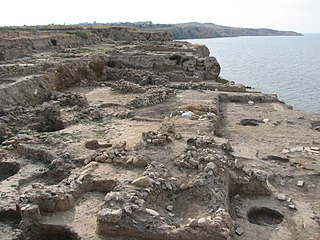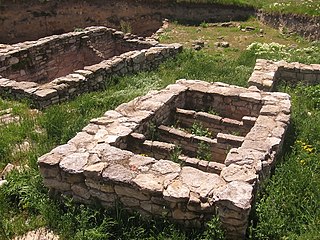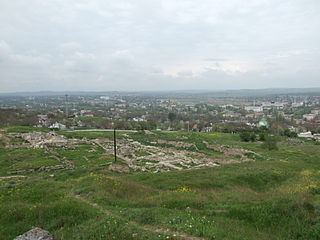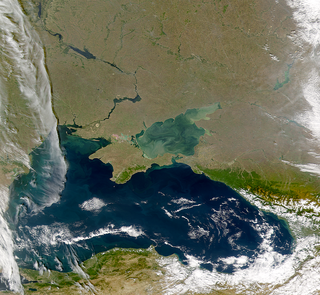
Kerch is a city of regional significance on the Kerch Peninsula in the east of the Crimea, Ukraine. Population: 147,033 .

Panticapaeum was an ancient Greek city on the eastern shore of Crimea, which the Greeks called Taurica. The city lay on the western side of the Cimmerian Bosporus, and was founded by Milesians in the late 7th or early 6th century BC, on a hill later named Mount Mithridat. Its ruins now lie in the modern city of Kerch.

The Bosporan Kingdom, also known as the Kingdom of the Cimmerian Bosporus, was an ancient Greco-Scythian state located in eastern Crimea and the Taman Peninsula on the shores of the Cimmerian Bosporus, the present-day Strait of Kerch. It was the first truly 'Hellenistic' state in the sense that a mixed population adopted the Greek language and civilization, under aristocratic consolidated leadership. Under the Spartocid Monarchs the aristocracy of the kingdom adopted a double nature of presenting as archons to Greek subjects and kings to barbarians which some historians consider unique in ancient history.The Bosporan Kingdom became the longest surviving Roman client kingdom. The 1st and 2nd centuries AD saw a period of a new golden age of the Bosporan state. It was briefly incorporated as part of the Roman province of Moesia Inferior from 63 to 68 AD, under Emperor Nero, before being restored as a Roman client kingdom. At the end of the 2nd century AD, King Sauromates II inflicted a critical defeat on the Scythians and included all the territories of the Crimea in the structure of his state.

Chersonesus, is an ancient Greek colony founded approximately 2,500 years ago in the southwestern part of the Crimean Peninsula. Settlers from Heraclea Pontica in Bithynia established the colony in the 6th century BC.

Tmutarakan was a medieval Kievan Rus' principality and trading town that controlled the Cimmerian Bosporus, the passage from the Black Sea to the Sea of Azov, between the late 10th and 11th centuries. Its site was the ancient Greek colony of Hermonassa founded in the mid 6th century BCE, by Mytilene (Lesbos), situated on the Taman peninsula, in the present-day Krasnodar Krai of Russia, roughly opposite Kerch. The Khazar fortress of Tamantarkhan was built on the site in the 7th century, and became known as Tmutarakan when it came under Kievan Rus control.
Chersonese is a name that was given to several different places in ancient times. The word is Latin; it derives from the Greek term for "peninsula", χερσόνησοςchersonēsos, from χέρσοςchersos + νῆσοςnēsos (island).

Phanagoria was the largest ancient Greek city on the Taman peninsula, spread over two plateaus along the eastern shore of the Cimmerian Bosporus.

Scythia or Scythica, also known as Pontic Scythia, was a kingdom created by the Scythians during the 6th to 3rd centuries BC in the Pontic–Caspian steppe.

Tyritáke was an ancient Greek town of the Bosporan Kingdom, situated in the eastern part of Crimea, about 11 km to the south from Panticapaeum. It is tentatively identified with the ruins in the Kerch district of Kamysh-Burun (Arshyntseve), on the shore of the Cimmerian Bosporus.

Myrmēkion was an ancient Greek colony in the Crimea. The settlement was founded in the eastern part of the modern city Kerch, 4 km NE of ancient Panticapaeum on the bank of the Kerch bay near the cape Karantinny. The settlement was founded by Ionians in the first half of the 6th c. BC.

Kimmerikón was an ancient Greek city in Crimea, on the southern shore of the Kerch Peninsula, at the western slope of Mount Opuk, roughly 40 kilometres southwest of modern Kerch. It was situated with its acropolis on the hills on the west side of the mountain. The town was founded by the Milesian colonists in the 5th century BC and flourished at the beginning of the Christian era. Its name may refer to an earlier Cimmerian settlement on the site.

Nýmphaion, also known as Nymphaion on the Pontus, was a significant centre of the Bosporan Kingdom, situated on the Crimean shore of the Cimmerian Bosporus. Today it is located near the resort town Heroivske/Geroevskoye. It lies at a distance of about 14 kilometers south of Kerch, which was the site of ancient Panticapaeum.

The recorded history of the Crimean Peninsula, historically known as Tauris, Taurica, and the Tauric Chersonese, begins around the 5th century BC when several Greek colonies were established along its coast, the most important of which was Chersonesos near modern day Sevastopol, with Scythians and Tauri in the hinterland to the north. The southern coast gradually consolidated into the Bosporan Kingdom which was annexed by Pontus and then became a client kingdom of Rome. The south coast remained Greek in culture for almost two thousand years including under Roman successor states, the Byzantine Empire, the Empire of Trebizond, and the independent Principality of Theodoro. In the 13th century, some Crimean port cities were controlled by the Venetians and by the Genovese, but the interior was much less stable, enduring a long series of conquests and invasions. In the medieval period, it was partially conquered by Kievan Rus' whose prince Vladimir the Great was baptised at Sevastopol, which marked the beginning of the Christianization of Kievan Rus'. During the Mongol invasion of Europe, the north and centre of Crimea fell to the Mongol Golden Horde, and in the 1440s the Crimean Khanate formed out of the collapse of the horde but quite rapidly itself became subject to the Ottoman Empire, which also conquered the coastal areas which had kept independent of the Khanate. A major source of prosperity in these times was frequent raids into Russia for slaves.
Chersonesus is an ancient city near Sevastopol, Crimea.

Asander, named Philocaesar Philoromaios was a Roman client king of the Bosporan Kingdom. He was of Greek and possibly of Persian ancestry. Not much is known of his family and early life. He started his career as a general under Pharnaces II, the king of the Bosporus. According to some scholars, Asander took as his first wife a woman called Glykareia, known from one surviving Greek inscription, "Glykareia, wife of Asander".
The Crimean Peninsula was under partial control of the Roman Empire during the period of 47 BC to c. 340 AD. The territory under Roman control mostly coincided with the Bosporan Kingdom . Rome lost its influence in Taurica in the mid third century AD, when substantial parts of the peninsula fell to the Goths, but at least nominally the kingdom survived until the 340s AD. The Eastern Roman Empire, the eastern part of the Roman Empire that survived the loss of the western part of the empire, later regained Crimea under Justinian I. The Byzantine Empire controlled portions of the peninsula well into the Late Middle Ages.
Leucon I of Bosporus also known as Leuco, was a Spartocid ruler of the Bosporan Kingdom who ruled from 389 to 349 BC. He was arguably the greatest ruler of the Bosporan Kingdom.

The Royal Kurgan or Tsarskiy Kurgan from the 4th century BC, is one of the most impressive tumuli (kurgans) of the eastern Crimea. The burial barrow is located in the present-day Kerch, which developed out of the ancient Greek town Panticapaeum (Παντικάπαιον) founded by Miletus.
Akra was an ancient Greek city at the Cimmerian Bosporus. The city is now underwater at the Kerch Strait, near the Naberezhne village in Crimea. It was flooded as a result of the transgression of the Black Sea and is now almost entirely immersed in the sea, with the exception of a small section at the Yanysh lake.




















